Sasa, Israel
Sasa
סָאסָא | |
|---|---|
 | |
| Coordinates: 33°1′37″N 35°23′40″E / 33.02694°N 35.39444°E | |
| Country | |
| District | Northern |
| Council | Upper Galilee |
| Affiliation | Kibbutz Movement |
| Founded | January 1949 |
| Founded by | Hashomer Hatzair members |
| Population (2022) | 396[1] |
| Website | www.sasa.org.il |
Sasa or Sassa (
History
The modern kibbutz was founded in January 1949 by a
.On the grounds of the kibbutz is the alleged tomb of Levi ben Sisi, who is usually believed to have died in far-away Babylonia during the first half of the third century.[4]
In 1950, the American correspondent Kenneth W. Bilby started his book "New Star in The Near East" - depicting the 1948 war and its aftermath - with an eyewitness account of Sassa: "Face Lifting". The Mukhtar of Sassa had fled, and his 2000 Arab villagers with him. By November 1949, 120 young American-born Jews had supplanted them, and the old village roosting on a Galilean hilltop had begun to acquire a Western flavor. The Mukhtar's home was being plastered and cemented into a communal shower. Power-driven lathes, imported from the United States, were turning out furniture for the new Jewish settlements which mushroomed in the Galilee. Prefabricated barracks with beaverboard interiors, fresh-painted American tractors, and an experimental windmill which resembled a radar antenna provided more accouterments of progress. Sassa, which had existed unchanged for over a thousand years, was on the altar - an offering, like the lambs of Abraham, for the betterment of the people of Israel".[5]
In 1992, the
Economy
Sasa operates Plasan, a plastics factory that manufactures vehicle armour. The company, which is shared between some 100 families, is now a world leader in armor protection technology for vehicles. The kibbutz has signed contracts worth billions of dollars with major clients,[7] including the U.S. military.[8]
Other branches of the economy include a dairy, in cooperation with kibbutz Tuval; a beef herd; fruit trees (kiwi, apple, avocado and grapefruit); Bereshit, a fruit marketing company in cooperation with three other kibbutzim; and Sasa Tech, a manufacturer of technical and home care products.[9] Buza, a chain of ice cream shops founded by a Sasa resident, runs a branch on the kibbutz and offers ice cream workshops.[10]
Gallery
-
Members of kibbutz Sasa in 1948
-
Kibbutz Sasa in 1949
-
U.S. AmbassadorDan Shapirovisiting Plasan, 2012
References
- ^ a b "Regional Statistics". Israel Central Bureau of Statistics. Retrieved 21 March 2024.
- Washington D.C.: Institute for Palestine Studies. p. 495
- ^ Ilan Pappé, "The Ethnic Cleansing of Palestine", page 183
- ^ Pictures of Tzaddikim's graves in Eretz Yisrael Yeshivat Tikun HaMidot
- ^ Kenneth W. Bilby, "New Star in The Near East", Doubleday (publisher), 1950,p.1
- ^ Khalidi, 1992, p. 497
- ^ Plasan Sasa wins contract
- ^ Kibbutz Sasa's Plasan nets second big U.S. military tender
- ^ Sasa website
- ^ the Sea of Galilee for the Galilee by the sea





